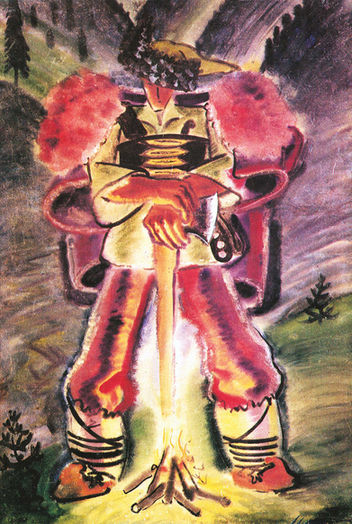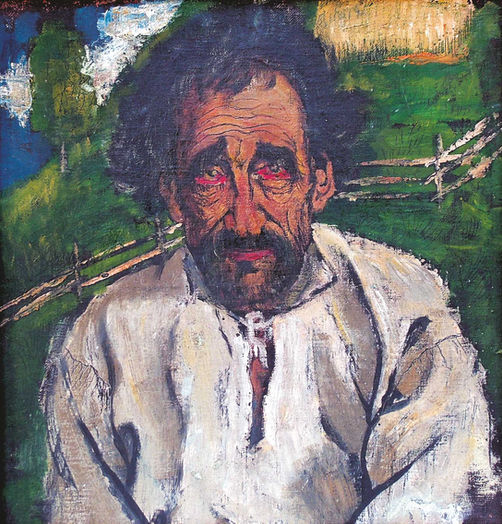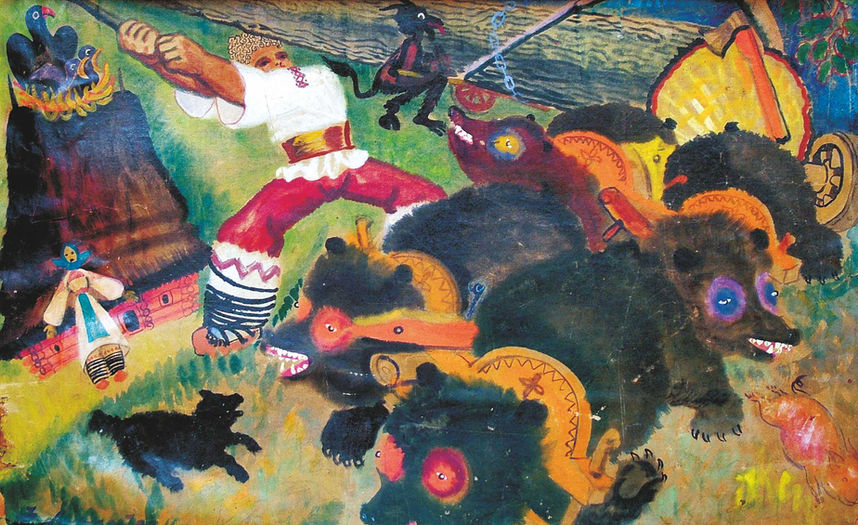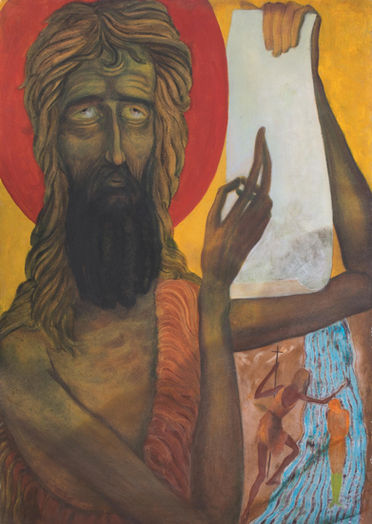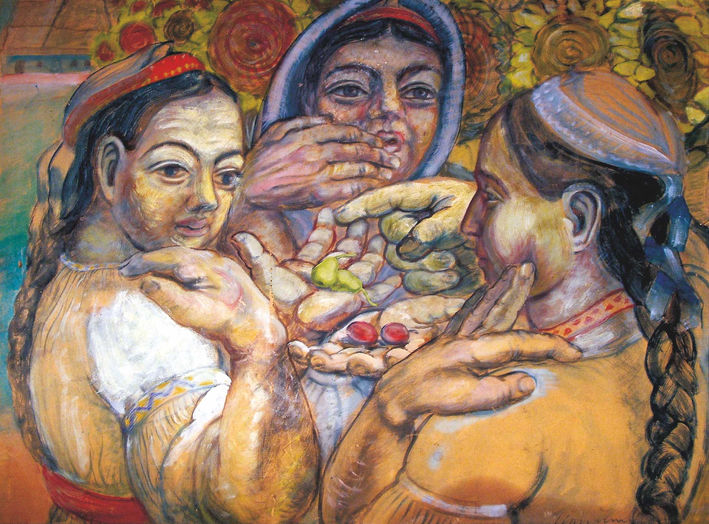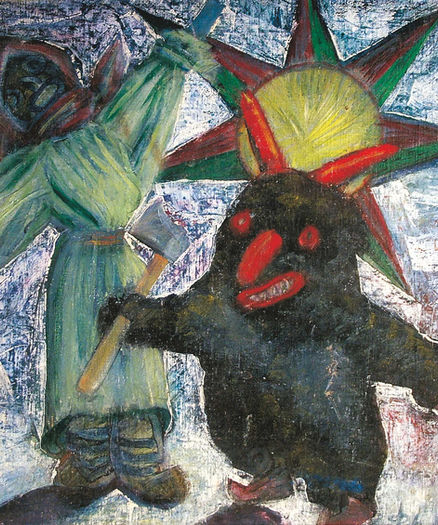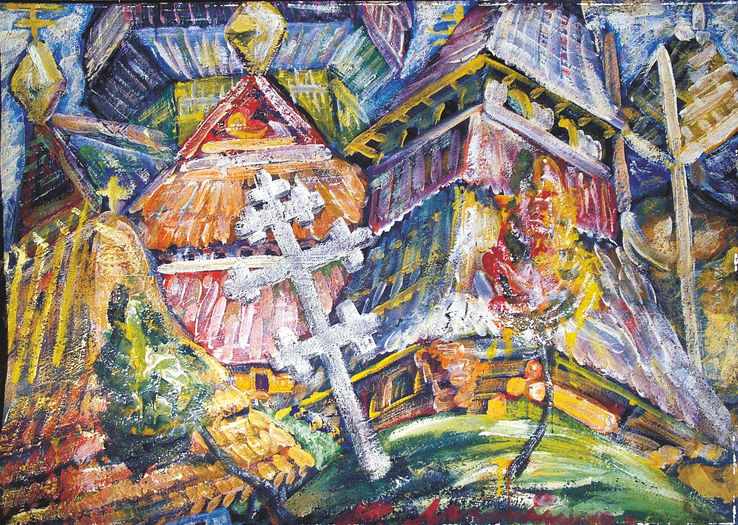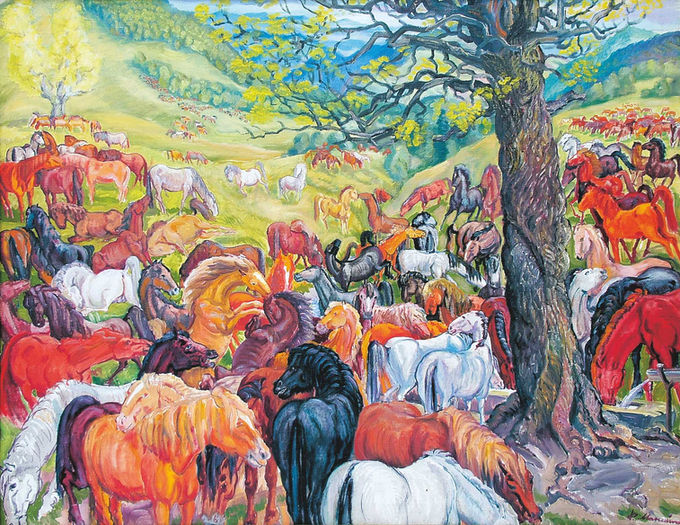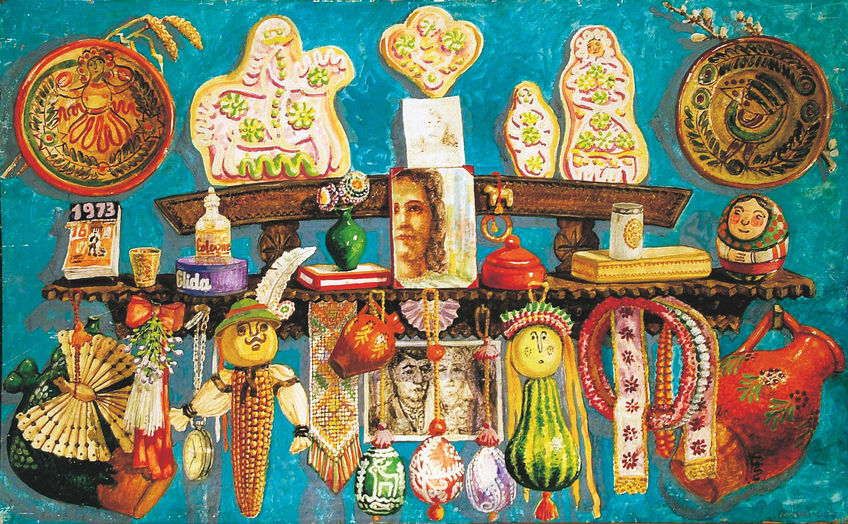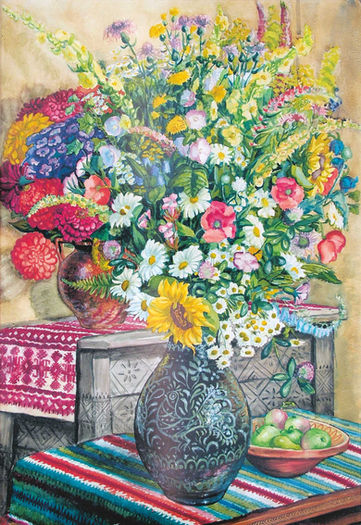
FEDOR MANAYLO
creative legacy of ruthenian artist

"The Prolific Palette of Fedor Manaylo:
A Symphony of Colours in Rusyn Culture"
"My art draws its lifeblood from folk tradition. Undoubtedly, the entire gamut of 'isms' - ranging from expressionism and Dadaism to Fauvism and primitivism - are nested within folk art, yet it is far from subservient to any of these doctrines. In essence, folk art is perpetually modern, for it encapsulates Art in its purest form."
- Fedor Manaylo.
Fedor Manaylo's artistic journey, underpinned by a profound dedication to his native Rusyn heritage, paints a canvas that seamlessly blends the aesthetics of folk art with an ethos that transcends the limitations of prevailing artistic 'isms'. Manaylo's oeuvre finds expression in the vibrant symbiosis between the human experience and the elemental might of the Carpathian landscape, presenting an interplay of the real and the mystical. His work reflects a contemplative duality, holding a mirror to the shared past of his homeland while offering a bridge to its future, in a spirit deeply resonant of Rusyn self-awareness. Despite the societal upheavals and changing cultural policies of his era, Manaylo's artistic spirit persevered, marking a turning point in the evolution of Transcarpathian culture. As a tireless advocate for folk art, a committed pedagogue, and a driving force in the Transcarpathian art community, his legacy extends beyond his art, engraving his name in the bedrock of universal Rusyn cultural history.
Andrew Manaylo
(From the research "The Manaylo Dynasty in Rusyn Culture")

"Resonances of Rusyn: The Transcendent Folk Modernism of Fedor Manaylo"
"Fedor Manaylo, a Rusyn artist, fervently married his homeland's folk art with avant-garde techniques, creating a distinctive artistic expression that underlines the transformative and perennially modern nature of folk art within the broader European context."
In the evocative words of Fedor Manaylo (1910 – 1978), an extraordinary artist and devout Rusyn patriot, we discover an undying homage to his roots - the rich tapestry of folk art. According to Manaylo, folk art is not simply a categorization, a delimited field, or a source of inspiration. Rather, it is a dynamic vortex that brings together a multitude of artistic ideologies, ranging from the fervor of expressionism to the unrestrained audacity of Dadaism, the riotous hues of Fauvism to the raw simplicity of primitivism. However, Manaylo asserts, folk art remains unshackled by these 'isms', transcending each to achieve an intrinsic modernity - a testament to the perpetuity of Art. This reverberating testament is enshrined in Manaylo's creative journey. Anchored by an unbreakable tether to his native land, Manaylo's artistic process was an intimate reflection of his personal love for his people and his homeland. This love, undeniably, shaped his foray into art, imbuing his work with a dedicated service to his fellow Rusyn people. Manaylo's European artistic education further sculpted his creative identity, introducing him to the liberating techniques of the avant-garde - expressionism, symbolism, Fauvism, etc. Particularly drawn to expressionism, Manaylo sought to emphasize the essence 'beyond the phenomenon', a triumph of spirit over matter. This drive towards 'expression', coupled with the vibrant hues and simplified forms characteristic of avant-garde art, allowed Manaylo to deftly portray the distinct world of Rusyn culture. In his portrayals, Manaylo creates a distinctive dialogue between the exoticism of Rusyn culture and the broader European context, drawing from the richly preserved heritage of the Rusyn people - their language, customs, and folk art. Through this endeavor, he presents not merely a collection of visual representations, but a deeply meaningful amalgamation of signs and symbols that construct, rather than reflect, the world. In the grand scheme of the European and Soviet cultures, Manaylo found his distinct artistic voice within the triangle of influences. Embracing his Rusyn identity, he navigated the stylistic undertows with an innate fear of losing his unique perspective. However, it was in this delicate negotiation between tradition and modernity, familiarity and the exotic, where Manaylo ultimately found himself, creating a unique artistic expression that fused his homeland's inherent beauty and character with the avant-garde techniques of the European masters. His art thus stands as a testament to the transformative power of folk art, underlining its timeless relevance and its ability to continuously redefine what it means to be 'modern'.
"The Ethereal Weave of Reality and Imagination:
Fedor Manaylo’s Homage to Subcarpathian Rus"
"Fedor Manaylo, a celebrated Rusyn artist, fervently married his homeland's folk art with avant-garde techniques, creating a distinctive artistic expression that underlines the transformative and perennially modern nature of folk art within the broader European context."




Diving into the oeuvre of Fedor Manaylo, one becomes privy to a period of intense artistic production from the late 1930s to the mid-1940s. This epoch, fraught with the specter of war and intense societal transformations, saw Manaylo artfully immortalize his beloved homeland on canvas, straddling the boundaries of the real and the imagined, the tragic and the joyous, the human and the elemental. Manaylo's artworks from this period, much like a lyrical ballad, strike an orchestral harmony of man, nature, and emotions. He displays an adroit ability to mirror life in its intricate nuances, each seemingly simple depiction imbued with profound philosophical depths. His unique aesthetic language evokes the paradoxical magic of an "artistic stylistic oxymoron" where opposing characteristics meld into a holistic, expressive narrative. People move with the fervor of fire, panoramas anthropomorphize, reflecting his embeddedness in a culture rich with tales and fables. Manaylo's works become a portal to the consciousness of Subcarpathian Rus, channelling theatrical spectacle, pictorial expression, and dramatic action. He ingeniously navigates the techniques of artistic metaphor, allegory, and symbolism, intertwining the language and philosophy of folk art with his individualistic creative flair. In this delicate dance between the imagined and the explicit, the viewer discovers a bridge between past and present, foreseeing a future that yearns for connection with its rich cultural past. Noted for his expressive colors and emotive intensity, Manaylo's paintings become a visual manifestation of his dedication to his land and people. Each stroke of his brush becomes a testament to shared collective experiences, creating a vibrant tableau of folk existence. Such unique artistic prowess did not escape the gaze of contemporary critics. Yevgeny Nedzelskiy, under the pseudonym A. Izvorin, underscored Manaylo's spiritual kinship with his people and the robustness of his artistic language. Noteworthy among the critics, Ernest Kallai emphasized Manaylo's artistic liberty, the fervor of his works, and a propensity towards the mystical. Manaylo's stylistic impact on Subcarpathian Rus' artistic culture was seminal, paralleled only by the landscapes of Josif Bokshai and the modern portraiture style of Adalbert Erdeli. His expressionist ethos came to represent the collective consciousness of the wartime Ruthenian intelligentsia, their experiences, anxieties, dreams, and hopes. Manaylo's influence extended to contemporaries like Laszlo Dvan-Sharpotoki, Adalbert Boretsky, and Ernest Kontratovich, resonating in the thematic richness and expressive intensity of their works. He also inspired a generation of artists whose creativity blossomed amidst the era of Soviet occupation, ensuring his legacy's continued resonance in the art world. In essence, Fedor Manaylo's works serve as an artistic compass, guiding us through the intricate labyrinth of Subcarpathian Rus' culture and history, and his passionate exploration of the boundaries of the real and the imagined illuminates the transformative power of art.
Fedor Manaylo paintings from the late 1930s to the mid-1940s




"The Phoenix Rises: Fedor Manaylo's Subversive Resilience in Soviet Subcarpathia"
"Subcarpathian artists, stifled by Soviet cultural policy in 1945, eventually rekindled their creative flame during the 'Khrushchev thaw'. Fedor Manaylo's pivotal exhibition 'Old and New Transcarpathia' catalyzed this artistic renaissance, navigating Soviet ideological confines and re-establishing pre-war expressive richness."
The year 1945 marked a significant pivot in the artistic trajectory of the Subcarpathia region as it was absorbed into the monolithic Soviet Union. What had once been a vibrant cauldron of creative evolution within the Transcarpathian School of Painting suddenly found itself under the stifling yoke of Soviet cultural policy. The artistic methodologies that had defined the school, rich in national substance and modern in form, were branded as alien, bourgeois, and thus unacceptable for Soviet Transcarpathian artists. Socialist realism was thrust into the spotlight, demanding an overtly realistic and socialist portrayal of the world, ostensibly accessible to the common worker and peasant. Artists were to celebrate a Soviet utopia that often belied the harsh realities of everyday life, populated by panoramas of revitalized Soviet landscapes and beaming portraits of proletariat leaders. This sweeping dictum of creative expression came as a shocking jolt to Subcarpathian artists such as Fedor Manaylo, who had been nurtured in an atmosphere of unfettered creativity. Faced with the draconian repercussions of noncompliance, many artists, including Manaylo, sought refuge in the ostensibly safe domain of landscape painting, stripping their works of political narratives. It wasn't until the 1960s, during the 'Khrushchev thaw', that the iron grip on artistic expression began to loosen, allowing artists to revisit their creative roots. Amidst this shift, the pivotal exhibition of Manaylo's work, titled 'Old and New Transcarpathia', unfolded from 1961 to 1964, cutting a swath through Uzhgorod, Lviv, Kiev, and Moscow. The exhibition showcased not only post-war landscapes, but also pre-1945 works that once faced persecution under Stalin's regime. Re-contextualized as responses to the grim reality of life under bourgeois Czechoslovakia and Hungary, these once taboo works were accepted, even lauded. Manaylo's post-war landscapes, brimming with lyricism and epic narratives of industrial progress, were held up by Soviet ideologues as proof of the Transcarpathian people's prosperity. This politically convenient narrative led to effusive praise for the artist from government outlets. The impact of this exhibition, however, extended far beyond Manaylo's personal acclaim. It sent ripples across the Transcarpathian culture and Ukraine, acting as a catalyst for an extraordinary creative resurgence. The influence of 'Old and New Transcarpathia' was apparent in the works of fellow artists, writers, poets, and playwrights, while also granting artists a broader palette of thematic content. In essence, this period signalled a return to the original sources of the regional school of painting of the 1920s and 1930s for Transcarpathian artists. Like a phoenix rising from the ashes, the artists, spearheaded by the indomitable spirit of Fedor Manaylo, continued to push the boundaries of creative expression despite the rigid confines of Soviet ideology.
"The Luminary of Uzhgorod: Fedor Manaylo's Enduring Impact on Transcarpathian Cultural Heritage"
"Fedor Manaylo's artistry extends beyond the canvas, shaping the cultural and educational contours of the Transcarpathian region. His significant contributions to local institutions, commitment to preserving regional heritage, promotion of unique folk traditions, and fostering of younger artistic generations form a multifaceted legacy."




The resplendent tapestry of Fedor Manaylo's life is not only woven from the brilliant threads of his artistic oeuvre but is also enriched by his relentless dedication to public and cultural initiatives. One cannot underestimate Manaylo's seminal role in shaping the cultural landscape of the Transcarpathian region, as his indomitable spirit left an indelible mark on numerous institutions. At the cradle of the Museum of Folk Architecture and Life, Manaylo emerged as an active force and thought-leader, utilizing his extensive knowledge of architecture, ethnography, and the Transcarpathian lifestyle to shape the museum's direction. His tireless dedication is woven into the very fabric of the institution, a testament to his commitment to preserving and promoting regional heritage. His influence also extended to the sphere of education. Manaylo was instrumental in establishing the Uzhgorod School of Applied Arts and took on the mantle of teaching, leaving an indelible impact on the generations of artists that followed. This proclivity for mentorship and his passion for inspiring young artists was reflected throughout his lifetime, marked by his fervent belief in the transformative power of education. Manaylo's leadership skills found a fitting platform in the Transcarpathian department of the Union of Artists, where he served as chair from 1948. His stewardship was characterized by a tireless dedication to strengthening the artists' collective, both creatively and organizationally. His contributions extended to the House of Folk Art, the Transcarpathian Ukrainian Music and Drama Theatre, the regional philharmonic, and the 'Carpathians' book publishing house. Furthermore, Manaylo shouldered the responsibility of safeguarding the unique folk art tradition of gourd decoration from oblivion, reaffirming his commitment to the preservation of cultural heritage.
Fedor Manaylo paintings created during the Soviet era




"Immortalized Impressions: The Fedor Manaylo Home-Museum and Its Unveiling of an Artist's Legacy"
"The Fedor Manaylo Home-Museum, Transcarpathia's first memorial museum, embodies the rich legacy of the revered artist. It intertwines Manaylo's personal journey with his artistic evolution, fostering an intimate exploration of his life and work. This cultural hub celebrates Manaylo's contribution to art, serving as a vibrant beacon of regional heritage."
In the vibrant cityscape of Uzhgorod, a beacon of artistic heritage shines brightly. Unveiled in 1981, the first memorial home-museum in Transcarpathia stands as a testament to the enduring legacy of one of its most revered sons, Fedor Manaylo. A sanctuary of cultural preservation, the museum is an homage to Manaylo's profound influence on the art scene and his ceaseless contributions to the rich tapestry of Transcarpathian cultural heritage. The museum offers visitors a unique journey into the heart of Manaylo's creative life. It houses an array of his personal belongings, serving as tangible markers of an artist's lived experience. These artifacts stand as silent storytellers, giving spectators an intimate glimpse into the man behind the artworks. They weave a narrative of Manaylo's life, offering a panoramic view of his journey, both as an artist and a citizen of Transcarpathia. This voyage through Manaylo's life is further enhanced by the museum's collection of documentary materials. These documents offer invaluable insights into his artistic process, ethos, and the broader socio-cultural context of his work. These archival materials breathe life into the annals of history, allowing visitors to traverse the timeline of his artistic evolution and to appreciate the confluence of personal, political, and cultural factors that informed his work. At the heart of the museum's vast collection, numbering approximately 2000 exhibits, lie Manaylo's artistic works. From captivating paintings and mesmerizing graphics to intricate sketches and studies, the spectrum of his oeuvre is showcased in all its splendor. Each work stands as a testament to Manaylo's mastery of form, his deep-rooted understanding of his homeland, and his ability to imbue his creations with a spirit of national identity. The collection displays the artist's stylistic versatility, his evolving themes, and the progression of his craft. It is a vibrant, visual anthology that underscores the breadth and depth of his creative genius. The museum serves not only as a tribute to Manaylo's contributions but also as a vibrant cultural hub, inviting visitors to engage with the rich artistic traditions of the Transcarpathian region. It is a link between the past and the present, a living testament to the timeless power of art, and a continuing source of inspiration for generations to come. In its essence, the Fedor Manaylo Home-Museum is more than a repository of art and history; it is an enduring beacon of cultural memory, perpetuating the legacy of a remarkable artist and his enduring impact on the Transcarpathian art scene. - Andrew Manaylo
Fedor Manaylo - Creative Legacy of Ruthenian Artist
FEDOR MANAYLO - Memorial Museum of National Artist


FEDOR MANAYLO - Memorial Museum of National Artist

Про Федора Манайла: геній не лем у малярстві!





